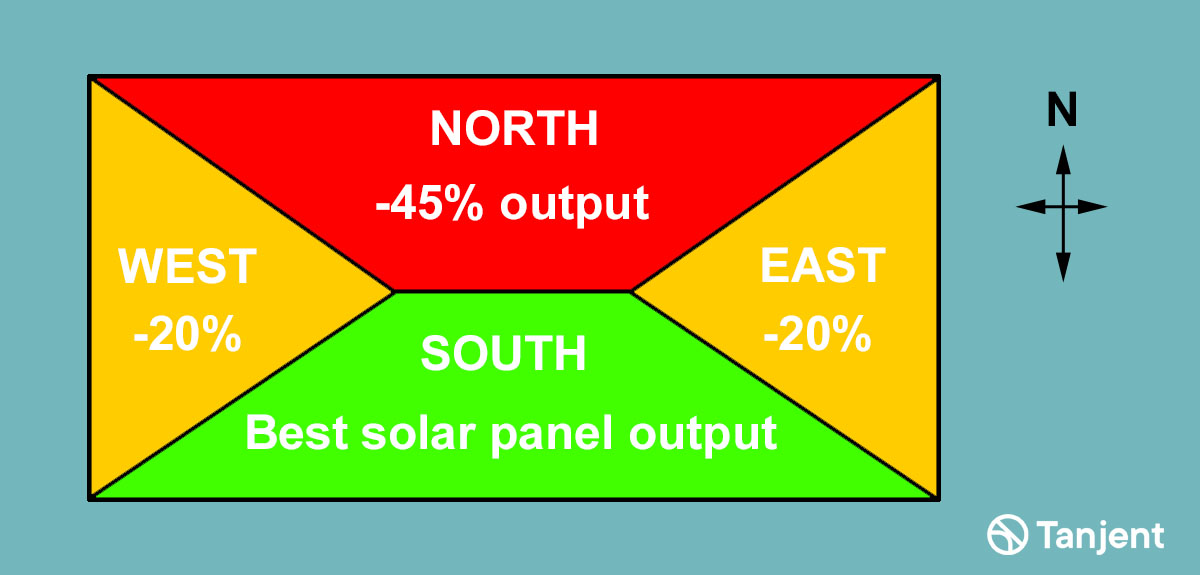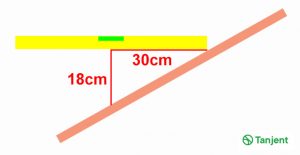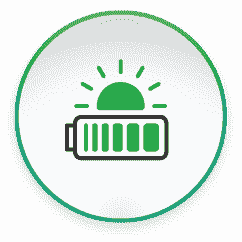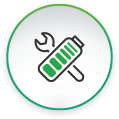In the world of renewable energy, solar power has become one of the most popular ways to generate electricity. Being able to produce your own energy and be in control of your own electricity supply is a fantastic way to save money and reduce your carbon footprint.
Tanjent have been installing solar panels since 2017. We’ve seen a lot of roofs in that time, and we know some can present issues.
Let us explore more about installing solar panels on your roof.
What is the Best Angle and Direction for Solar Panels
To generate the most electricity solar panels should ideally be mounted in a south-facing direction and angled at a pitch between 30-40 degrees – the exact angle will depend on your latitude. This set-up will give your solar panels exposure to the sun for the longest period, resulting in more energy generation for your home.
Whilst a south-facing roof is preferable, reliable performance can also be found on an east and west facing roof – with eastern rooftops getting most sun exposure in the morning and west facing in the afternoon and evenings.
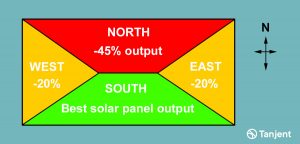
Solar panel output and the effect of orientation – UK midlands, pitch about 30 degrees (Image: T. Larkum/Tanjent)
What is the simplest and most accurate way to calculate which direction your roof faces?
• Compass: Try a free compass app on a smartphone.
• Google Maps: Enter your postcode and locate your home.
If the map is orientated to the north and your roof is orientated to the bottom of the Google view, this means you have a south-facing roof.
What About North Facing Roofs and Brand-New Roofs?
We would not advise installing solar only on a north facing roof because it won’t generate more than about 60% of the equivalent south roof. However, it can be a useful addition if you’ve run out of space to put panels on other roofs.
An alternative could be to install ground mounted solar panels, if you have good, open and unshaded ground to use.
Bear in mind if considering solar on a brand-new roof this could invalidate your roof warranty, check with your contractor beforehand.
Our customers ask us if they can have solar on a flat roof – The answer is yes, but be aware of potential pitfalls and also extra costs as it is likely you will want the panels mounted on adjustable frames. This will allow you to position the panels at the optimum angle and direction. If you are unsure, speak to one of our design team who can provide more information (email sales@tanjent-energy.com).
If you do not use the correct sloped frames, you will also need to factor in rainfall which can cause ‘pooling’ on the panels, leading to their deterioration, especially around the seal. The extra cleaning maintenance can be a frustration for many flat-roof owners; when compared to panels installed on a slope, that generally maintain themselves.
Roof Type
Roof material can have a significant impact on the cost of your solar installation, and the home’s suitability for solar. For example, installing solar panels on slate roofs is a lot more labour-intensive, and requires additional materials which have to be considered.
Although solar panels can be installed on most roofs, there are 3 types of roofs which are a no-go. These are Thatch roofs, Asbestos roofs, and Glass roofs:
1. Thatch roofs: As there is an increased risk of fire.
2. Roofs containing Asbestos: As this is a safety hazard for installation teams to work with.
3. Glass roofs: As they are too fragile to support the solar panels and fixings.
Check with your local Council if solar panels are allowed on your property – i.e., in a Conservation Area or a Listed Building.
The Shape and Size of your Roof
The next factor to keep in mind is the size and shape of your roof. If your roof is too small or has awkward angles, the panels will not be able to get the sunlight they need. The pitch of your roof also matters – solar panels work best when installed on pitched roofs.
To know if your roof is suitable for solar you should categorise what pitch you have.
How to calculate roof pitch
Roof pitch is measured as a vertical rise relative to a horizontal run. For example, a roof which rises 18 cm every 30 cm has a 18 in 30 pitch. To convert this to an angle use a calculator, where angle = inverse tan (up/along), so here angle = inverse tan (18/30) = 30 degrees.
A roof pitch will impact the amount of energy your solar panels collect from the sun – most are installed flush in-line with the roof pitch and raised a short distance above.
Roof Space
Does this mean the bigger the roof, the more solar panels?
The answer here is, is your roof large enough to install enough solar panels to cover your energy bill – do you want to power an electric vehicle, heated swimming pool, energy in a blackout or be as grid-independent as possible?
Do your neighbours have panels?
If they do, this could give you an indication of how many panels you could have.
Here are some typical numbers:
- 2 bed home = 12 panels
- 3 bed home = 16 panels
- 4 bed home = 20 panels
- 5 bed home = 24 panels
Roof Condition
To have solar panels installed on your property, your roof needs to be structurally sound and in good condition and strong enough to hold the weight of the panels. Prior to an installation, all certified installers should evaluate the condition of your roof to see if the roof is structurally sound. Signs of a damaged roof include: falling mortar, a rotting underlay, loose or missing tiles, mould and moss growth, water damage and rotting roof trusses, battens or purlins. A roof in poor condition will need treatment prior to considering solar panels.
Roof Shading
Shading can be a be-all and end-all factor as shading will limit the amount of sunlight your roof gets exposed to, and therefore reduce your system’s output.
Shading can be caused by many external factors such as nearby trees, buildings, chimneys, satellite dishes, and waste vents. It is important to identify if the shading is Dynamic (Temporary) or Static (Permanent), and how much of an impact it will have on your system’s performance.
Although shading may only appear on one panel, because solar panels are wired together in a ‘string’ the entire system’s performance is affected. There is of course technology to help reduce the impact of shading on a solar panel system, these are known as DC Power Optimisers. Installing either Solaredge or Tigo panel optimisers come with several benefits. However they will add to the cost of your total installation.
If Solar is not suitable on your property, see this link for other ways to make your home environmentally friendly/sustainable.



